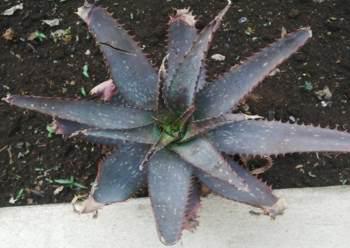Aloe mudenensis
Aloe mudenensis Reynolds
Family: Asphodelaceae
Common names: Muden aloe (Eng.); kleinaalwyn (Afr.); icena (IsiZulu)
Introduction
Aloe mudenensis is one of the most attractive spotted aloes, endemic to Muden and Karkloof in KwaZulu-Natal.

Description
Description
Aloe mudenensis is an evergreen succulent that is short-stemmed, reaching up to 800 m high. The leaves are straight, broad, 175 – 350 × 50 – 90 mm, with a bluish green colour. The leaves have several scattered spots, especially on the upper surface.
Aloe mudenensis inflorescence is branched, with up to 8 racemes, up to 1 m tall; racemes are dense, cylindri-conical, 175 mm long. Flower colour varies from yellowish-orange to red. Flowering occurs in winter to spring, depending where it grows.
Conservation Status
Status
The species is currently not threatened.
Distribution and habitat
Distribution description
Aloe mudenensis is endemic to Muden in northern KwaZulu Natal. It may also be found southwards in the Karkloof Valley, situated between Howick and Wartburg.
Derivation of name and historical aspects
History
The name Aloe is derived from the Greek alsos, which refers to the bitter juice from the leaves of these plants. It is probably derived from the earlier Arabic word alloeh or the Hebrew word allal, both meaning ‘bitter'. The specific epithet mudenensis, refers to the region or the natural home that the species occurs in, namely the Muden Valley.
Ecology
Ecology
Aloes are well adapted in dry and hot environments and are pollinated by sunbirds.
Uses
Use
Aloe mudenensis makes a great accent plant. It is also very suitable as a container plant and small aloes can be used very effectively as border plants at the edge of a bed. Although aloes can grow on rocky areas, their application in horticulture is not limited to this feature and they can be used in almost any setting together with garden plants.
This succulent plant is popular in cultivation and is not used medicinally.
Growing Aloe mudenensis
Grow
Position Aloe mudenensis in an area that gets full sun for at least half the day. The area must also have good drainage, such as a slope, a north-facing slope being the best.
Despite Aloe mudenesis being a hardy plant, it still requires nutrients to thrive. The best way to ensure healthy plants is to prepare the soil correctly with organic compost before planting and then feed every few years. If Aloe mudenensis becomes too dry, the leaves will wrinkle up and the colour will fade. Regular irrigation, especially in dry weather, will keep them lush, however, if they are exposed to too much water, the leaves will drop or the whole plant will rot.
They can also be propagated from seeds which germinate easily, if sown in well-drained soil and lightly covered with fine sand.
References
- Pooley, E. 2005. A field guide to wild flowers KwaZulu-Natal and the eastern regions. The Flora Publications Trust, Durban.
- Van Wyk, B. & Smith, G. 1996 . Guide to aloes of South Africa. Briza Publications, Pretoria.
- Westacott, G. 1982. The aloes of South Africa. Balkema, Cape Town.
Credits
Ntokoza Nkosi
KwaZulu-Natal NBG
November 2014
Plant Attributes:
Plant Type: Succulent
SA Distribution: KwaZulu-Natal
Soil type: Loam
Flowering season: Spring, Winter
PH: Neutral
Flower colour: Red, Yellow, Orange
Aspect: Full Sun
Gardening skill: Average
Special Features:
Horticultural zones










Rate this article
Article well written and informative
Rate this plant
Is this an interesting plant?
Login to add your Comment
Back to topNot registered yet? Click here to register.